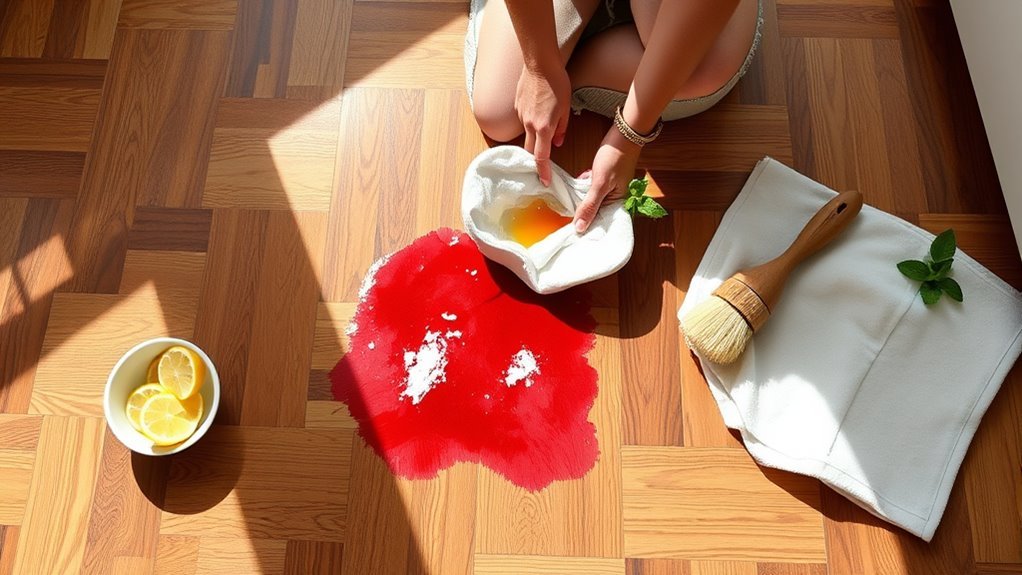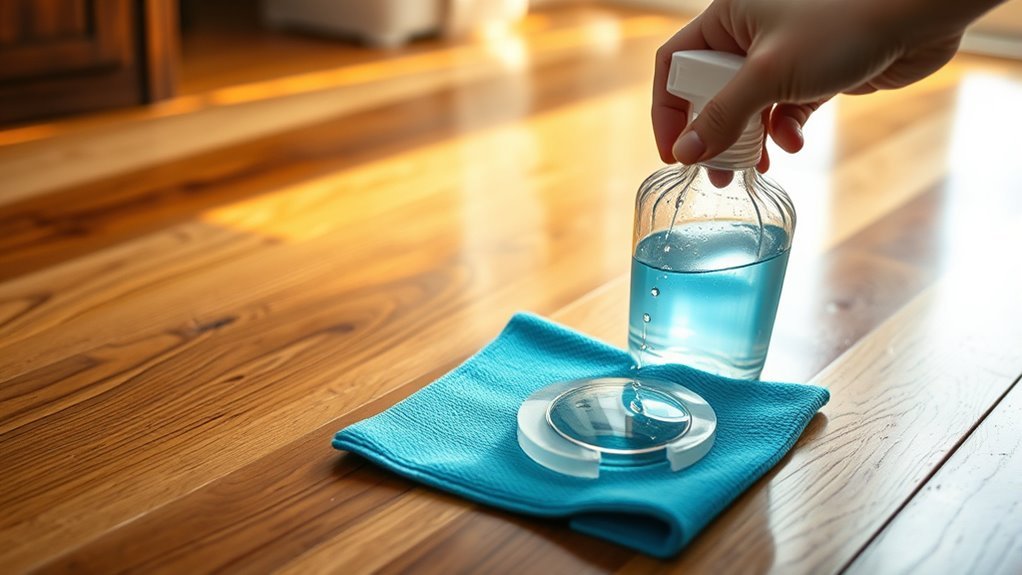How to Clean Stains Floors
To clean floor stains effectively, first identify the type—organic, inorganic, or synthetic—to choose the right cleaner. Use pH-neutral solutions for hardwood and baking soda paste with grout cleaner for tile stains. Blot spills immediately without rubbing, and rinse areas well after treatment. For carpets, vacuum regularly and address spots promptly with mild detergent. Prevent stains by using mats and sealing grout. Explore further to master detailed methods and maintenance tips for all flooring types.
Identifying Different Types of Floor Stains

Before you can effectively clean stains on floors, you need to identify the type of stain you’re dealing with. Stain identification is essential because each stain type demands a specific cleaning approach. Begin by observing the stain’s color, texture, and origin. Common classifications include organic stains (like food or pet accidents), inorganic stains (such as rust or mineral deposits), and synthetic stains (including ink or paint). Understanding stain classification helps you select the right treatment, avoiding damage to the floor. For example, organic stains often require enzymatic cleaners, while inorganic stains might need acidic solutions. By accurately identifying the stain, you gain control over the cleaning process, ensuring you restore your floor’s appearance efficiently and confidently, granting you the freedom to maintain your space without unnecessary trial and error.
Essential Tools and Materials for Floor Cleaning
Knowing the type of stain you’re tackling shapes the tools and materials you’ll need for effective cleaning. Having the right cleaning supplies guarantees efficient floor maintenance and preserves your flooring’s integrity. Equip yourself with essentials tailored to your floor type and stain severity.
| Tool | Zweck | Floor Type |
|---|---|---|
| Microfiber Mop | Gentle, effective debris removal | Hardwood, tile |
| Scrub Brush | Tackles stubborn stains | Tile, concrete |
| Cleaning Cloths | Spot treatment, drying | All floor types |
Alongside these, keep a bucket, gloves, and pH-neutral cleaners ready. Proper tools catalyze your freedom to maintain spotless floors without damage or excessive effort.
Using Natural Cleaners for Stain Removal

You can tackle stains effectively using natural cleaners like vinegar, baking soda, and lemon juice. Applying these substances correctly—whether through spot treatment or gentle scrubbing—is key to avoiding damage. Always test a small area first and follow safety guidelines to protect both your floors and yourself.
Common Natural Cleaners
Natural cleaners offer an effective and eco-friendly way to tackle stains on various floor types. Two of the most reliable agents you can use are a vinegar solution and baking soda. Vinegar solution, typically a mix of equal parts white vinegar and water, works by breaking down acidic or alkaline stains without harsh chemicals. Baking soda, a gentle abrasive, lifts dirt and neutralizes odors when sprinkled on the stain and combined with moisture. Both are safe for hardwood, tile, and laminate floors, making them versatile choices. You can mix baking soda into a paste with water for tougher stains or use it dry for light cleaning. These natural cleaners give you the freedom to maintain your floors without exposing yourself or your environment to toxic substances.
Application Techniques
Although natural cleaners are gentle, applying them correctly is essential for effective stain removal. Begin by lightly dampening a clean cloth with the cleaner, avoiding oversaturation to prevent prolonged moisture exposure. Gently blot the stain instead of rubbing, promoting ideal stain absorption without spreading it further. Allow the solution to sit briefly, usually 5 to 10 minutes, to break down the stain molecules. Then, use a soft brush or cloth to lift the residue carefully. Remember, the cleaning frequency depends on the stain’s nature and floor material; regular, timely applications prevent buildup and maintain your floor’s integrity. By mastering these techniques, you’ll confidently use natural cleaners to remove stains efficiently while preserving your floor’s appearance and your freedom to maintain a healthy home environment.
Safety and Precautions
When handling natural cleaners for stain removal, it’s vital to prioritize safety to protect both yourself and your flooring. Always wear personal protective gear like gloves and goggles to prevent skin and eye irritation. Even natural ingredients can cause reactions or damage if mishandled. Use appropriate cleaning equipment—soft cloths, non-abrasive scrubbers, and well-ventilated spaces—to avoid scratching floors or inhaling fumes. Test the cleaner on a small, hidden area first to confirm compatibility. Store natural cleaners safely, away from children and pets, and label your mixtures clearly. By following these precautions methodically, you maintain your freedom to clean effectively without risking harm, preserving your floors’ integrity and your well-being. Safety is the foundation for achieving spotless results confidently.
Techniques for Cleaning Hardwood Floors

When tackling hardwood floor stains, start by gently removing surface marks with a soft cloth and appropriate cleaner to avoid damage. For deeper stains, you’ll need to use specialized cleaning methods that reach beneath the wood’s finish without compromising its integrity. Understanding these techniques guarantees your floors stay clean and well-maintained over time.
Removing Surface Stains
A key step in removing surface stains from hardwood floors is identifying the type of stain you’re dealing with. Different stains—like water, food, or ink—require specific treatments to avoid damage. Start by gently wiping the area with a damp cloth and mild soap to see if the stain lifts. For stubborn surface stains, use a hardwood floor cleaner designed for your finish. Avoid harsh chemicals that can strip the wood’s protective layer. After cleaning, dry the area promptly to prevent moisture absorption. Consistent stain prevention is essential; place mats in high-traffic areas and clean spills immediately to maintain your floor’s integrity. By addressing surface stains quickly and methodically, you preserve both the beauty and freedom of your hardwood floors for years to come.
Deep Cleaning Methods
Although regular surface cleaning keeps your hardwood floors looking good, deep cleaning is necessary to remove embedded dirt and grime that surface methods can’t reach. Employing effective deep cleaning techniques guarantees your floors stay pristine and durable. Here’s a clear method to follow, incorporating stain removal strategies that don’t harm the wood.
| Schritt | Technique | Zweck |
|---|---|---|
| 1. Dust & Vacuum | Use microfiber mop & vacuum | Remove loose dirt |
| 2. Apply Cleaner | pH-neutral hardwood cleaner | Break down grime |
| 3. Scrub Gently | Soft brush or sponge | Dislodge embedded stains |
| 4. Wipe Excess | Feuchtes Tuch | Avoid water damage |
| 5. Dry Thoroughly | Air dry or fan | Prevent warping |
Stick to these methods for effective, safe deep cleaning and stain removal on hardwood floors.
Methods for Removing Stains From Tile and Grout
Since tile and grout are porous materials, stains can easily set in if not addressed promptly. To effectively remove stains, start with a grout cleaning solution—mix baking soda and water into a paste, apply it to the grout lines, and let it sit for 10 minutes. Then, scrub using a stiff brush to lift stains without damaging the surface. For tougher spots, use a vinegar and water solution, but avoid overuse to prevent grout deterioration. After cleaning, rinse thoroughly and dry the area to prevent moisture buildup. For stain prevention, seal the grout with a high-quality sealant every six months. This methodical approach guarantees your tile and grout stay clean and stain-free, giving you the freedom to maintain a fresh, polished floor with minimal effort.
Tips for Cleaning Carpeted Floors
Many carpet stains can be tackled effectively if you act quickly and use the right techniques. Start by blotting the stain gently with a clean cloth to absorb excess liquid—never rub, as it can spread the stain. Use a suitable carpet cleaner or a DIY mix of mild detergent and water, applying it sparingly. Work from the outside of the stain inward to prevent spreading. After treatment, rinse with plain water and blot dry. Regular carpet maintenance, such as vacuuming and spot cleaning, helps keep fibers free of dirt and ready to resist stains. While stain prevention is essential, prompt action and proper cleaning methods are your best tools to restore your carpet’s appearance and extend its life.
Preventative Measures to Keep Floors Stain-Free
To keep your floors looking pristine, you’ll want to implement preventative measures that minimize the risk of stains before they occur. Start by establishing consistent floor protection routines, such as placing high-quality mats at entrances to trap dirt and moisture. Use area rugs in high-traffic zones to shield your floors from spills and wear. Regularly clean up spills immediately to prevent absorption, and avoid walking indoors with shoes that carry dirt or grime. Consider applying a sealant suitable for your floor type to create a protective barrier against stains. These stain prevention strategies not only preserve the floor’s appearance but also extend its lifespan, giving you the freedom to enjoy your space without constant worry over damage. Staying proactive is your best defense in maintaining flawless floors.
Häufig gestellte Fragen
Can Professional Cleaning Services Remove Old Floor Stains Effectively?
You’ll find that professional cleaning services excel at stain removal, especially for old, stubborn marks. They use advanced cleaning techniques tailored to different floor types, which you might not have access to at home. These experts assess the stain’s nature and select the most effective method, ensuring your floors regain their original look without damage. So, if you want freedom from persistent stains, trusting professionals is a smart, efficient choice.
Are There Any Floor Stain Removers Safe for Pets and Children?
Isn’t it ironic that some stain removers claim to be powerful yet could harm your kids or pets? Luckily, you don’t have to choose between cleanliness and safety. You’ll find pet friendly solutions and child safe cleaners designed specifically to tackle stains without toxic chemicals. Just look for products labeled non-toxic and biodegradable. Following instructions carefully, you’ll keep your floors spotless while ensuring a safe environment for your loved ones. Freedom to clean safely is yours!
How Often Should Floors Be Professionally Sealed After Deep Cleaning?
When it comes to floor maintenance, sealing frequency depends on the type of floor and its usage. Generally, you should have your floors professionally sealed every 1 to 3 years after deep cleaning to maintain protection and durability. High-traffic areas might require more frequent sealing, while low-traffic spaces can last longer. Staying on top of sealing guarantees your floors stay resilient and looking great, giving you the freedom to enjoy your space without worry.
What Are the Best Products for Removing Paint Stains From Floors?
Removing paint stains from floors can feel like trying to erase the sky! You’ll want to start with paint thinner, which breaks down stubborn spots effectively. Always test it on a hidden area to guarantee color matching with your floor’s finish. For water-based paints, a gentle soap and warm water might suffice. Remember, patience and precision are your allies, letting you reclaim your floor’s freedom without damage.
Can Floor Stains Cause Permanent Damage if Not Treated Promptly?
Yes, if you don’t treat floor stains promptly, they can cause permanent damage. Stains can seep deep into floor materials, making them tough to remove later. For effective stain prevention and floor maintenance, it’s essential to address spills or marks immediately. Staying proactive helps preserve your floor’s appearance and durability, giving you the freedom to enjoy a clean, beautiful space without worrying about lasting blemishes or costly repairs down the line.






